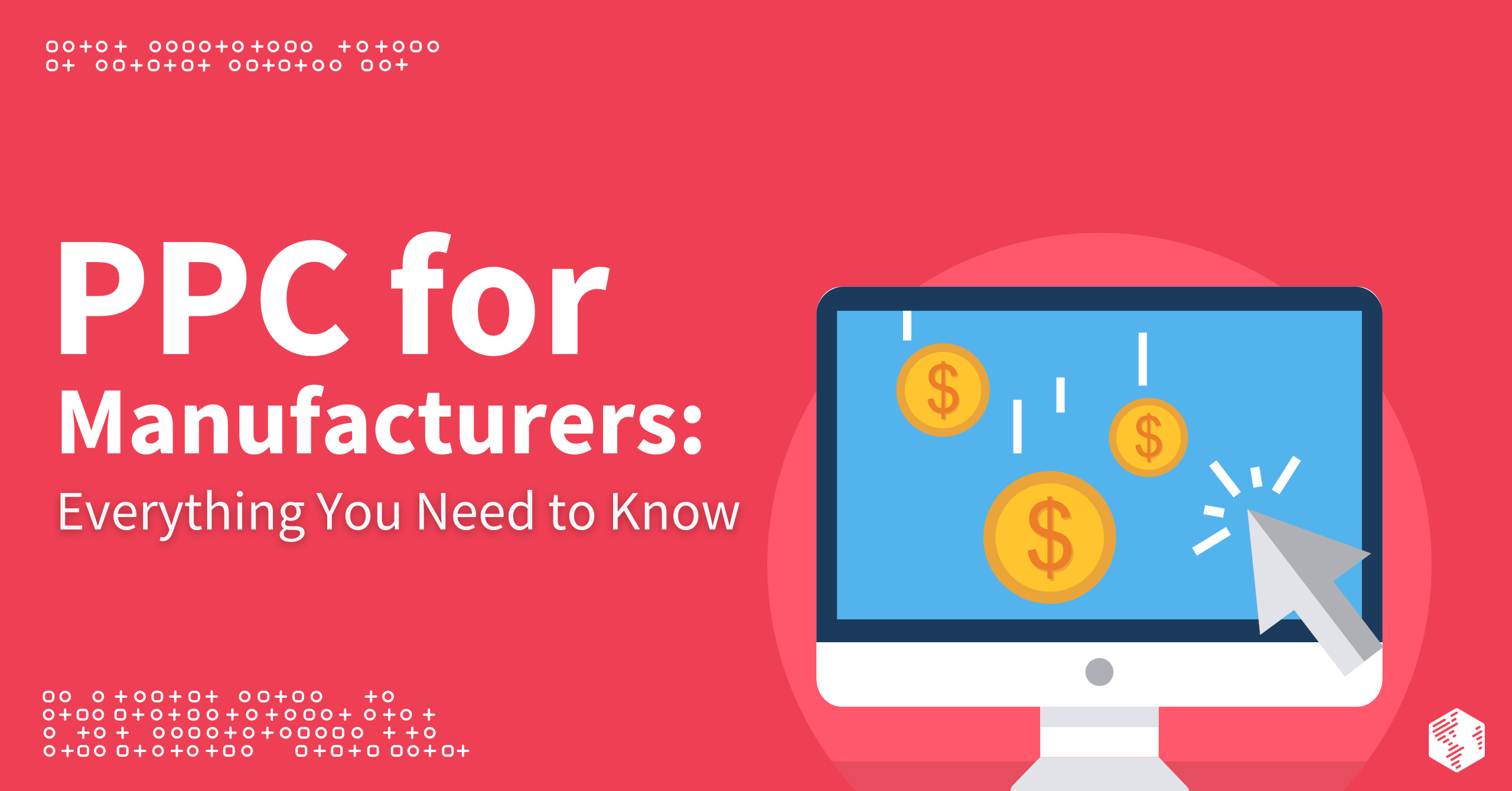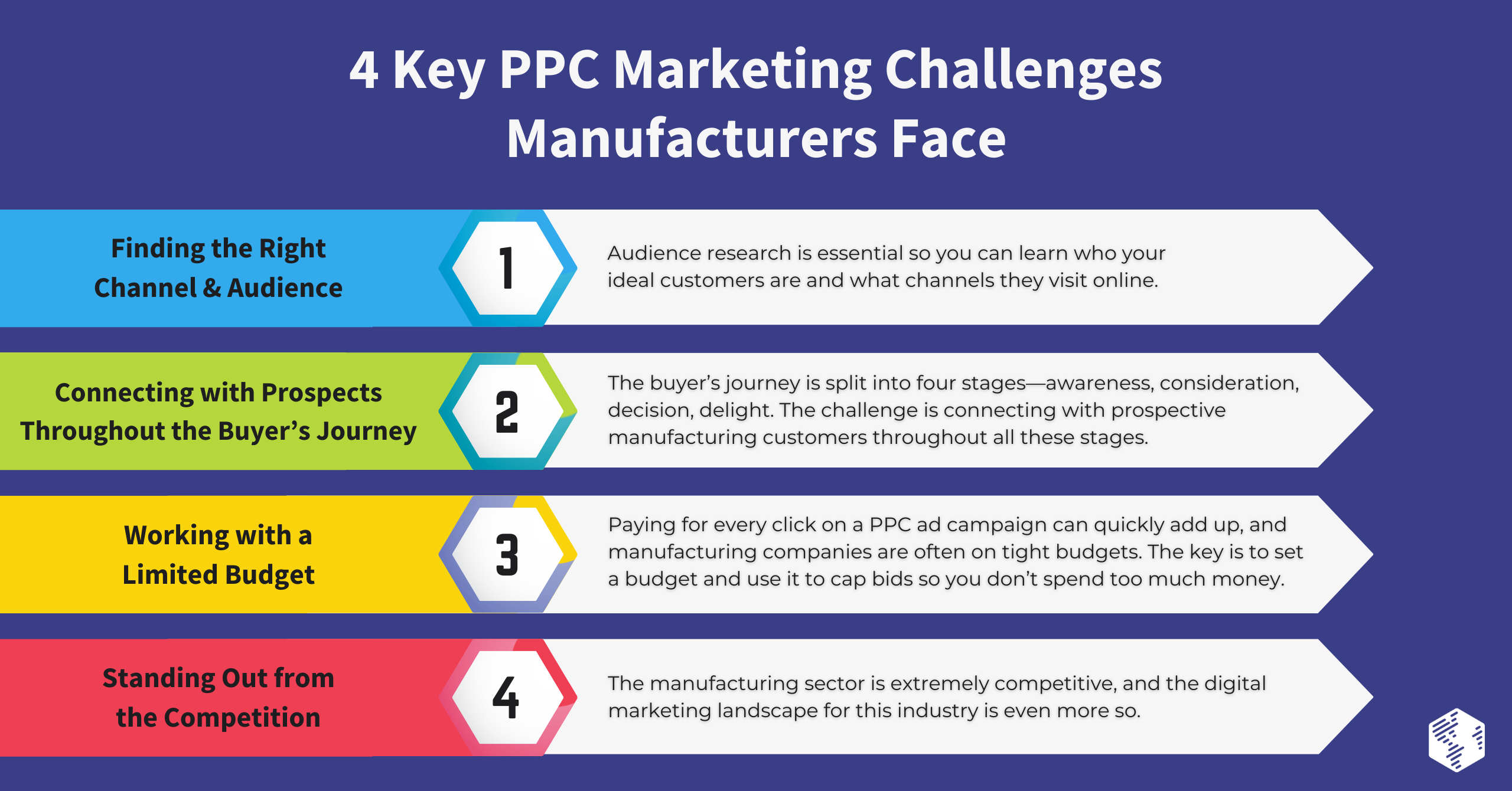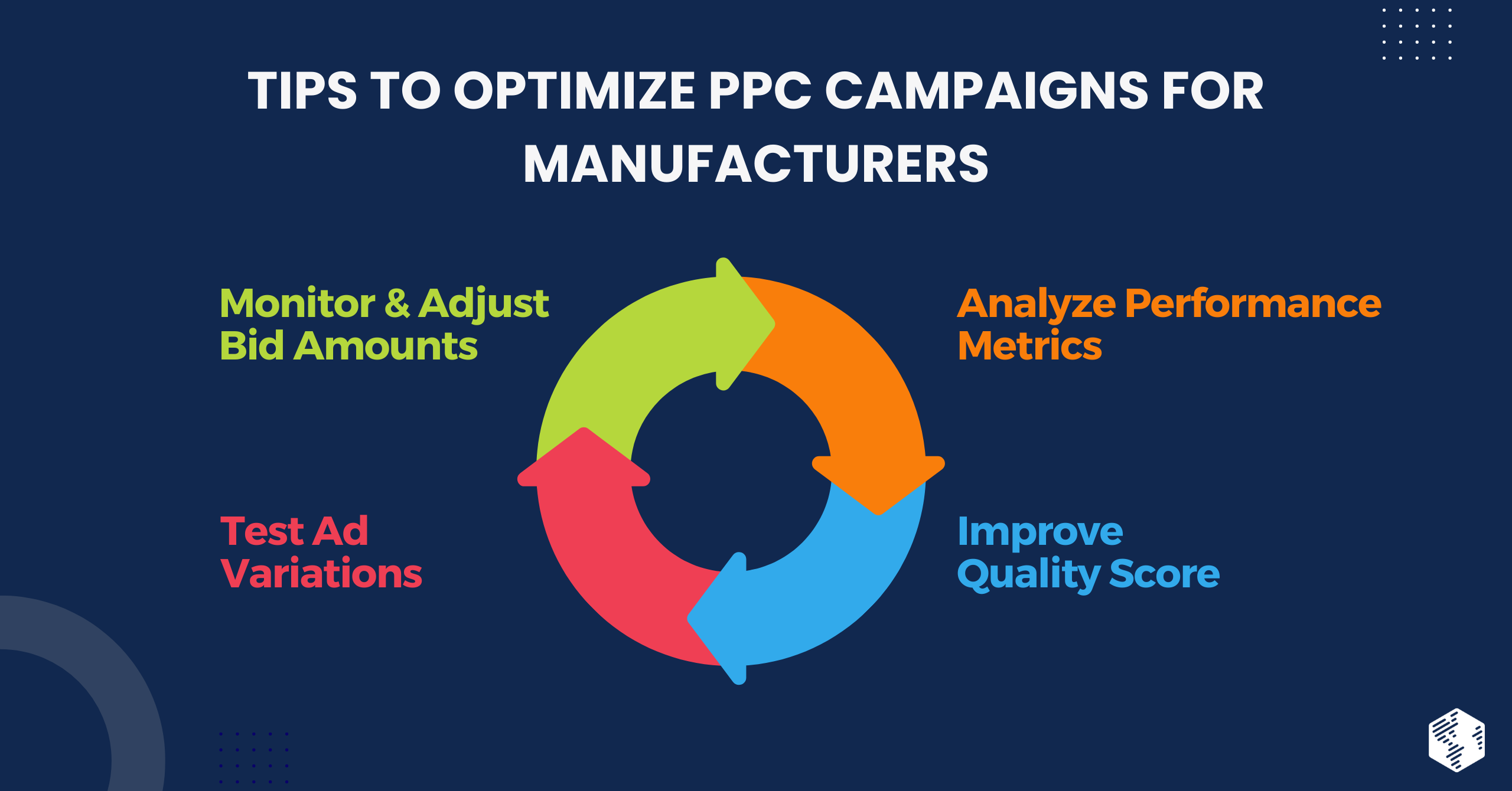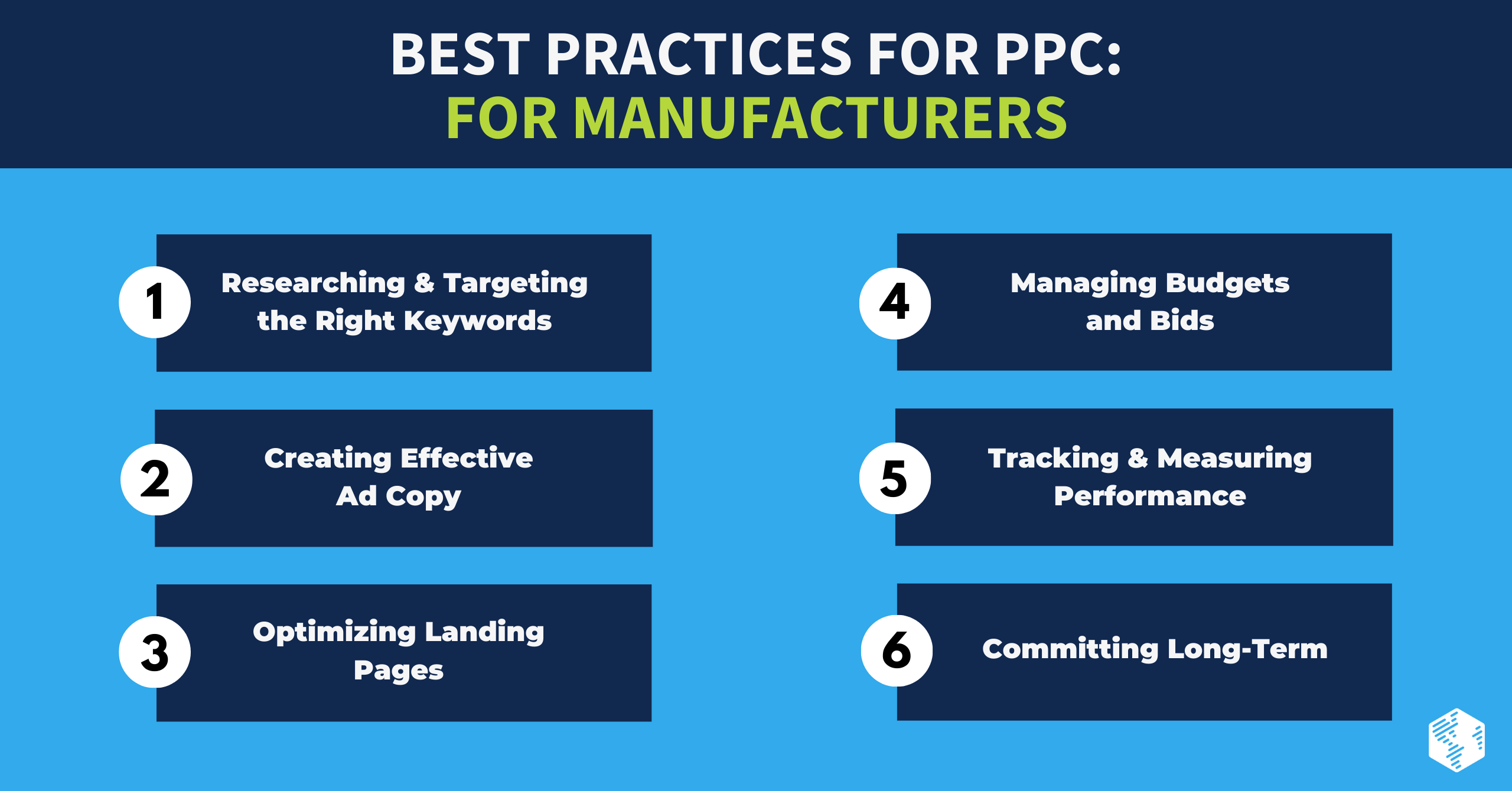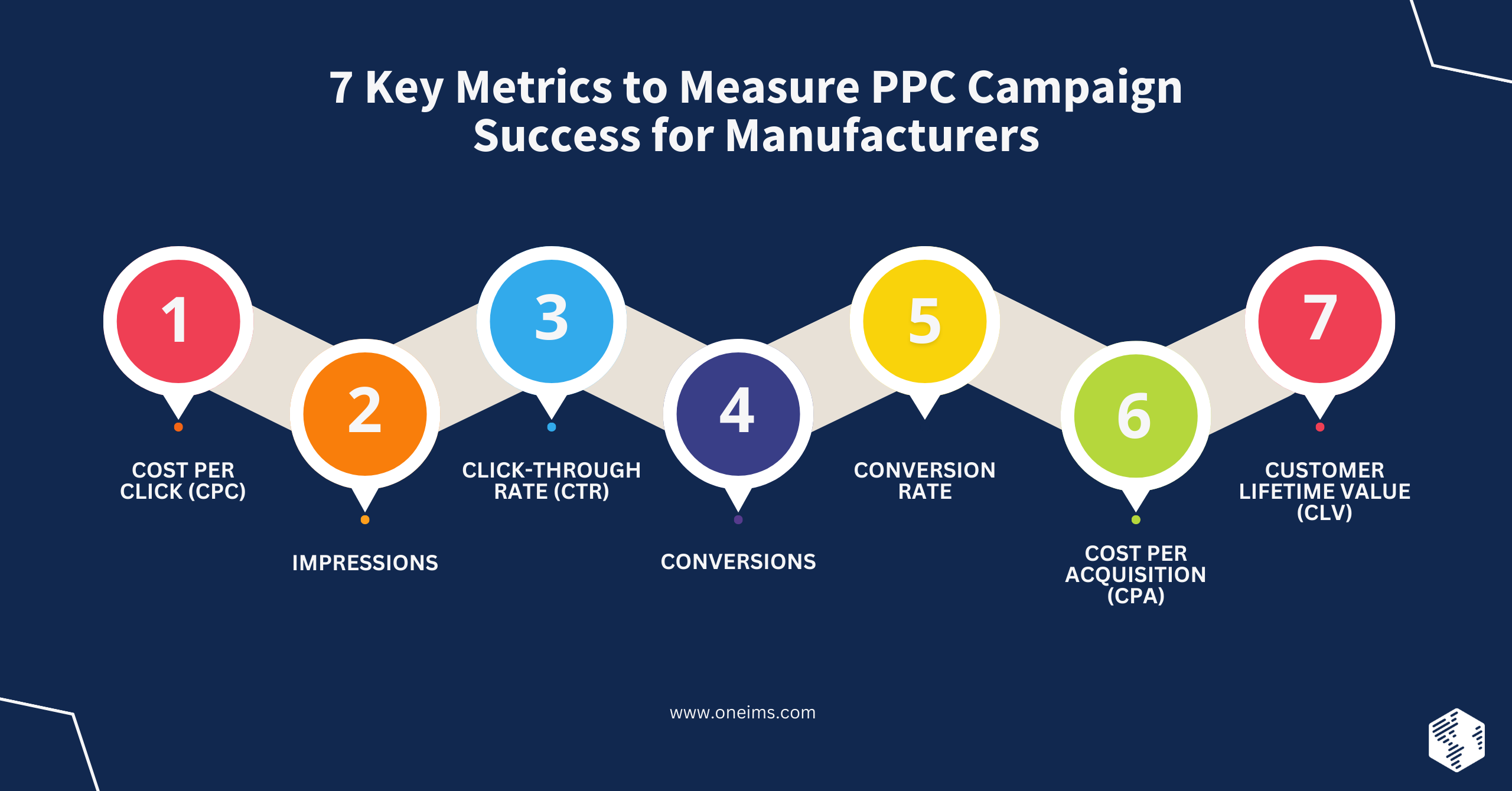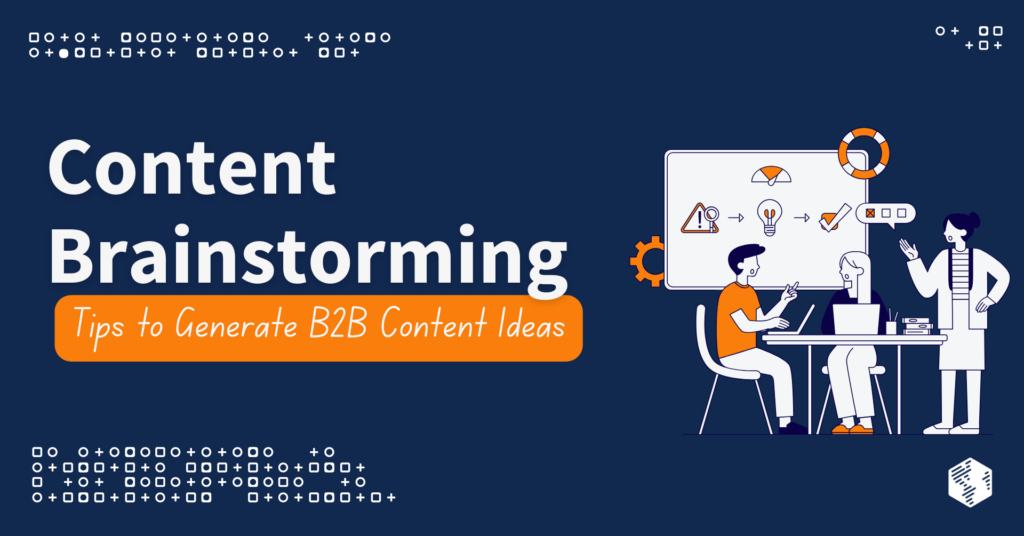If your manufacturing company wants to increase sales, attract new buyers, and retain existing customers, consider investing in a tried-and-true advertising method used by companies around the world.
Pay-per-click (PPC) advertising campaigns are one of the quickest and most reliable ways to secure valuable real estate on search engines, reach customers on social media, and generate new leads. Business-to-business (B2B) companies looking to grow can benefit from a strong, data-driven, effective PPC campaign.
Understanding the Basics of PPC for Manufacturers
Your prospective customers are spending time online. The best way to get your brand in front of them is by putting your name online, too.
PPC marketing is a type of online advertising model that helps companies appear at the top of search engine results pages (SERPs), throughout social media feeds, and in other places to catch the attention of your ideal customers. It is generally considered a cost-effective method that results in a positive return on investment (ROI) for manufacturing businesses and other B2B companies.
How PPC Ads Work
Google, Facebook, and other PPC channels hold online auctions where companies can bid on keyword phrases that relate to their products, services, or brand. Then, when people search for those words or phrases, your PPC ad will appear above organic search results on SERPs or on the social media pages of your target audience.
This process means that when a prospective customer searches for those keywords, they see the most relevant options first—ideally, your manufacturing company.
You only pay a fee when someone clicks on your ad, which is why this type of ad is called “pay per click.”
Types of PPC Ads
There are five main types of PPC ad campaigns:
- Paid search ads: Appear at the top of SERPs
- Paid social ads: Show up in social feeds or on social media profiles
- Remarketing ads: Use cookies or contact lists to target people who have previously engaged with your company or website
- Display ads: Take the form of banners, images, or text ads that appear on external websites across the internet
- Video ads: Appear before, during, or after online videos
Additionally, PPC ads can take the form of text, videos, or images. Some have call options where viewers can click a phone number to connect directly with your company.
PPC Channels
Popular PPC channels and advertising platforms include Google Ads (formerly AdWords), Microsoft Ads (formerly Bing Ads), LinkedIn Ads, and Facebook Ads (including Instagram Ads). You can conduct audience research to determine which platform your ideal customers will interact with most.
4 Key PPC Marketing Challenges Manufacturers Face
The manufacturing industry faces many unique challenges that affect paid ads, including PPC campaigns. Manufacturing companies need to understand how to create PPC ads that overcome these obstacles—or at least work around them to find success.
1. Finding the Right Channel & Audience
It’s difficult to find B2B manufacturing clients online. Audience research is essential so you can learn who your ideal customers are and what channels they visit online. Then, you can market directly to those prospects using PPC ads and other digital marketing strategies.
2. Connecting with Prospects Throughout the Buyer’s Journey
The buyer’s journey is split into four stages—awareness, consideration, decision, delight. The challenge is connecting with prospective manufacturing customers throughout all these stages.
Toward the beginning of the buying process, PPC ads can be used to build awareness of your products or solutions. In the later stages, prospects are actively evaluating purchase options, so PPC ads might not be effective.
B2B manufacturing companies have to connect with buyers throughout the buying process, be persistent in engaging with prospects, and invest in a variety of marketing strategies to find customers at the right time.
3. Working with a Limited Budget
Paying for every click on a PPC ad campaign can quickly add up, and manufacturing companies are often on tight budgets. The key is to set a budget and use it to cap bids so you don’t spend too much money.
4. Standing Out from the Competition
The manufacturing sector is extremely competitive, and the digital marketing landscape for this industry is even more so. You are vying for the same top PPC ad placements as your competitors, and space is limited.
How to Optimize PPC Campaigns for Manufacturers
Paid ads have the potential to be wildly successful, especially in the manufacturing industry. To improve your chances of an effective advertisement, optimize these four aspects of every PPC ad campaign.
Monitor & Adjust Bid Amounts
A bid is the maximum amount of money you are willing to pay per click. These bid prices are adjustable throughout your PPC campaign, so you can increase or decrease your bids based on how well your ads are performing.
When a keyword performs well, you can increase the price to improve your visibility on search engines or social media sites. Similarly, you can add a negative bid adjustment to poorly performing keywords to decrease the price.
Analyze Performance Metrics
You can’t just launch a PPC ad campaign and let it do its thing—at least, not if you want to reach your revenue and growth goals. Instead, you have to constantly keep track of performance metrics, analyze the results, and use these insights to create more effective PPC campaigns.
Test Ad Variations
The beauty of PPC ads is that you can make adjustments to campaigns while they’re running.
Make small changes to your landing page, target keyword, headline, and description for each PPC and then perform A/B split tests to see what improvements made a positive difference.
Improve Quality Score
Google and other PPC platforms use a rating called a quality score (QS) to measure the relevance and quality of your ad, copy, and landing pages. A high QS will increase your rank on SERPs and decrease your cost per click, while a low QS results in decreased ad placement at a higher cost.
Improve your QS by creating optimized, relevant, useful ads that viewers are compelled to click.
Best Practices for PPC for Manufacturers
Successful PPC ad campaigns can bring in new business, increase revenue, drive growth, and bring a positive ROI. Unsuccessful PPC marketing, on the other hand, is a drain on your marketing resources and a waste of money.
Follow these best practices to ensure your PPC campaigns end up on the positive end of the spectrum.
Researching & Targeting the Right Keywords
Most PPC platforms depend on keywords, so researching and targeting the right keywords is an important part of the PPC campaign planning process.
Determine what keywords and keyword phrases are both closely related to your products or services and match the search patterns of your ideal buyers. These keywords will serve as the foundation of your PPC ads.
Creating Effective Ad Copy
A PPC ad is composed of a headline, a description, a display URL, and a destination URL:
- Headline: Draws attention to the PPC ad
- Description: Provides information about relevant products or services
- Display URL: Identifies the main URL of your website (the home page)
- Destination URL: Shows the URL of ad’s landing page
Both the headline and description have character limits on most PPC channels, so they need to tell a story and share your brand in a short amount of space.
Here are our top tips for creating compelling PPC ad copy:
- Avoid excessive capitalization or punctuation
- Ensure copy is readable and accessible on both desktop and mobile browsers
- Create engaging, specific calls to action (CTAs)
- Include the main keyword phrase you are bidding on
- Speak directly to your target buyer persona
- Refrain from using misleading language
Ad copy can be tested and changed throughout the campaign—you’re not limited to your initial description or headline. Still, even though you can create multiple versions, keep these tips in mind.
READ: B2B PPC: How to Use Paid Search to Drive Business Leads and Revenue
Optimizing Landing Pages
When someone clicks on your PPC ad, where will the link take them?
Creating a high-quality, targeted, optimized landing page will compel visitors to convert into leads or become paying customers. A strong CTA is required, just like in your ad copy.
Landing pages can be custom-built to align with your PPC ad campaign, or you can send people to another relevant page on your website. Either way, ensure the page is optimized so visitors are more likely to make a purchase.
Managing Budgets and Bids
PPC ad budgets and bids can easily get out of hand. Consider the maximum price you want to allocate to attracting a prospect to your landing page through PPC ads, and use that number to set a bid limit. Then, you can carefully manage your bids, make sure you stay on budget, and keep track of your ROI.
Tracking & Measuring Performance
After launching your PPC ads, track and measure campaign performance. Based on the data you gather and what is happening with each ad campaign, you can make adjustments to see which keywords, ad copy, or landing page will drive the strongest results for your business.
Committing Long-Term
It may take more than a month or two to see significant results from even the strongest PPC ad campaigns.
Converting viewers who click on PPC ads to qualified leads or customers requires building trust and relationships. To see the best outcome, keep at it and commit to the long-term success of your PPC campaigns.
Common PPC Manufacturing Mistakes to Avoid
Running a successful PPC campaign requires careful planning, a lot of research and data collection, and extensive monitoring. It can be a challenge to keep all the plates spinning—especially because B2B companies are often managing more than one PPC campaign at a time!
With so much to keep track of, it’s no surprise that mistakes can happen. But they don’t have to happen to you.
Keep these common PPC mistakes in mind as you plan your paid ad campaigns.
Overbidding on Keywords
Overbidding on keywords can be a drain on your marketing and advertising budget. Focus your resources on keywords that will lead to actual conversions.
Targeting Irrelevant or Overly Broad Keywords
Knowing your audience is a vitally important part of managing PPC campaigns. With buyer personas in mind, you can identify the right keywords to target instead of wasting time and money on irrelevant or overly broad keywords.
Failing to Optimize Landing Pages
If your landing pages aren’t optimized, visitors will be more likely to bounce.
Make sure each landing page is optimized for search engines, includes relevant contact information, and provides a positive impression so that visitors will be persuaded to make a purchase.
Neglecting to Add Negative Keywords
Negative keywords are phrases closely related to your target keywords. They can be added to your PPC campaigns to ensure you don’t waste clicks on unqualified traffic. These words tell search engines and social media channels what keywords you do not want to get traffic from, helping to hone in on your ideal keyword phrases.
Measuring & Tracking Ad Performance Ineffectively
PPC campaigns require meticulous measuring and tracking. They offer rich data that can be used to figure out what is working and what is not. If you’re not tracking and measuring ad performance, you’re missing out on valuable opportunities for improvement.
READ: 10 Best B2B Marketing Analytics Tools You Need to Know
7 Key Metrics to Measure PPC Campaign Success for Manufacturers
Here are some key performance indicators (KPIs) and metrics you should track within each PPC campaign. The data you glean from these numbers will help you determine which ad campaigns are successful and where you should further invest your resources.
1. Cost Per Click (CPC)
Cost per click (CPC) measures the amount you pay for a single click on your ad. CPC acts as your bid in a PPC auction, where the best ad placements require higher bids.
The CPC for your PPC ad depends on many different factors, including the platform you are using, the keywords you are targeting, the industry you serve, the quality of your ad, the amount of competition you are facing for that spot.
2. Impressions
The number of impressions equates to the number of people who view your ad—whether they click on the ad or not doesn’t affect this number. This result can show what percentage of viewers find your PPC ad interesting or helpful enough to click on it.
3. Click-Through Rate (CTR)
Your click-through rate (CTR) identifies the number or percentage of clicks your ad receives. In other words, CTR shows the number of clicks compared to the amount of impressions your ad receives.
READ: PPC Metrics: How to Measure PPC Campaign Success and Increase Revenue
4. Conversions
Conversions are prospective buyers who view and click on your PPC ad, become qualified leads, go through the sales pipeline, and make a purchase.
The conversion process starts with leads. Marketing qualified leads (MQLs) meet specific criteria that indicate they are interested in your products or services but not yet ready to convert. Sales qualified leads (SQLs) are highly interested leads that are pre-qualified by the sales team who are (almost) ready to buy.
PPC landing pages should be tailored to each of these lead groups in order to boost conversion rates.
5. Conversion Rate
The conversion rate is the percentage of people who become a lead or customer after clicking on your PPC links. You can use this number to see if your ad campaigns are engaging, interesting, helpful, or valuable enough to encourage viewers to go through the sales pipeline and make a purchasing decision.
6. Cost Per Acquisition (CPA)
Cost per acquisition (CPA) is the total number of conversions resulting from your PPC ads compared to your total ad spend. You can use CPA to determine how much business revenue your PPC ads have created.
7. Customer Lifetime Value (CLV)
Customer lifetime value (CLV)—also known as simply lifetime value (LTV)—is a measurement that gives a glimpse into the net profit of a customer throughout their entire relationship with your company. It is a calculation of the total revenue the average buyer minus expenses, including ad spend.
A low CLV could indicate that spending money on PPC campaigns won’t return a high ROI. A high CLV means you may be able to spend more resources on acquiring customers overall.
Launch Successful PPC Manufacturing Campaigns at OneIMS
If you want to reach new customers and get an edge on your competition, it may be time to invest in PPC marketing.
The good news is that anyone can conduct keyword research, write compelling ad copy, and launch a PPC campaign. The better news is that you can partner with PPC experts to create and manage your PPC marketing strategy.
At OneIMS, our experienced team of PPC professionals is ready to help your manufacturing company optimize your landing pages, target your ideal customers, and grow your business with paid ads. We have a long history of working with industrial and manufacturing companies to develop innovative and data-driven marketing solutions, and we pride ourselves on producing measurable and sustainable results.
But you don’t have to take our word for it. View testimonials from our clients and read our blog to get an idea of our training, experience, and track record of success.
Are you ready to invest in PPC marketing? Schedule a consultation with us today to get started.


